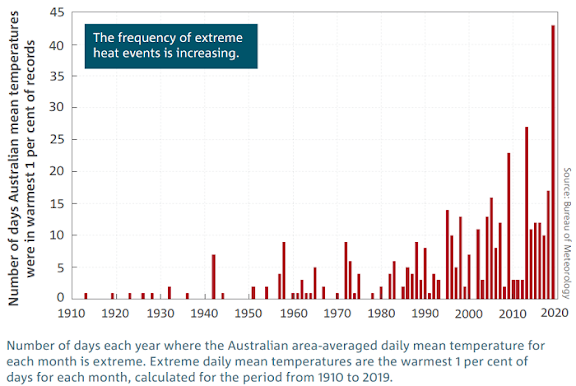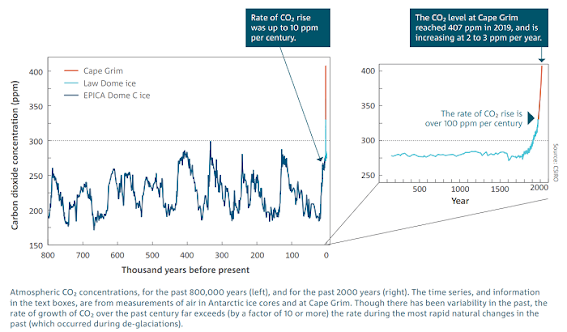https://www.abc.net.au/news/2020-11-13/bom-and-csiro-state-of-the-climate-2020/12871690
The Bureau of Meteorology and the CSIRO have teamed up for the latest biannual report on the climate, and the findings are clear: Australia is experiencing climate change now, and the warming trend is continuing.
We are now up to 1.44 degrees Celsius of warming since 1910, plus or minus 0.24C, resulting in increased extreme heat days, heatwaves and raised fire danger.
Karl Braganza, manager of the climate environmental prediction service at the Bureau, said the science had been broadly consistent and largely accurate in the way that it had portrayed and projected the climate system for the last several decades.
"What we are seeing now is a more tangible shift in the extremes, so we are starting to feel how that shift in the average is impacting on the extreme events," he said.
"We don't necessarily feel the 1.44 degree increase in Australia's average temperature but we feel those heatwaves and we feel that fire weather."
In the two years since the last State of the Climate report we have lived through 2019, the hottest year on record, which produced one of the worst fire seasons we have ever seen.
Dr Jaci Brown, research director at the CSIRO's climate science centre, says that in 10 to 20 years' time, 2019 will not be seen as unusual.
"In fact, we think of this decade being hot, but this decade will be one of the coolest in the next hundred years," according to Dr Brown.
Fire threat
This time last year swathes of the east coast were already on fire and Sydney had just faced down catastrophic fire danger.
It fits the trend of the fire season starting earlier and hitting with increasing intensity.
"Absolutely we are saying that Australia should prepare for an increased fire risk," Dr Braganza said.
He said the sort of fire events seen since the 2003 fires in Canberra were not one-offs.
"They are the sort of events we should treat as becoming more and more likely as warming continues."
Dr Brown was emphatic: "The message is very clear here. The State of the Climate report shows warming, it shows conditions drying through parts of Australia, and the projections are for hotter and dryer conditions going forward."
Changes in rainfall
Many parts of the country have seen a welcome change, with wetter conditions in recent months, but that does not mean we are out of the woods long-term.
Southern cool season rainfall is expected to continue to decline.
Three quarters of hydrologic reference stations across the country show a declining trend in streamflow.
According to Dr Brown, a lot of climate change is locked in, and so adaptation is a big part of what we do from now.
"Australian farmers, for example, are very used to dealing with climate variability and coming up with clever ways to manage and adapt," she said.
"New types of crops, new things to plant, new ways to work together to keep ourselves strong through these next few decades."
In contrast, northern warm season monsoonal rainfall has been above average over the last two decades.
But this rainfall remains inconsistent. Both the last two wet seasons recorded below-average rainfall.
As the atmosphere and oceans continue to warm, heavy rainfall is expected to become more intense.
Ocean sinks
As we have pumped CO2 into the atmosphere the oceans have acted as a sink for both CO2 and heat.
But that has not come without an impact upon our oceans.
Surface waters around Australia are estimated to have had a 30 per cent increase in acidity since the 1880s, and sea levels have risen by 25cm globally since 1880 as a result of thermal expansion and ice melt.
The rate of sea level rise is increasing. It is now up to an average of 3cm per decade globally, but this is dependent on location.
Australia's northern and south-eastern coasts have been well above the global average, with the north-eastern and southern coastlines closer to average.
Although the total number of tropical cyclones is expected to decrease in the future, warmer oceans, higher sea levels and more intense rainfall all increase the risk posed by tropical cyclones in the future.
2020 slowdown not enough to stem the tide
Even 2020's global slowdown hasn't been enough to stop atmospheric concentrations of CO2 from increasing.
Dr Brown said there was a drop in the rate of increase of CO2, but that the slowdown was indistinguishable from the background variability.
"Another way to think about this is, if you have been eating junk food for 10 years and then you go on a diet for one day and you jump on the scales the next morning expecting to see some change, drop a dress size.
"It is not that simple. This is about a very long-term change"
CO2 concentrations in our atmosphere are now well above any level reached in the last 800,000 years.
"I think the big challenge for our children and our grandchildren will be how to flatten this curve," Dr Brown said.
This year
Australia is currently under the influence of the La Niña phase of the El Niño Southern Oscillation.
La Niña events are typically associated with wetter-than-average conditions for all but the south-west.
Currently this year's La Niña is not tracking to be as severe as the last major La Niña in 2010/2011, but the Bureau will continue to monitor how the oceans warm over spring.
There is an increased risk of flooding for the east and north, with an above average risk of cyclones this summer.











No comments:
Post a Comment